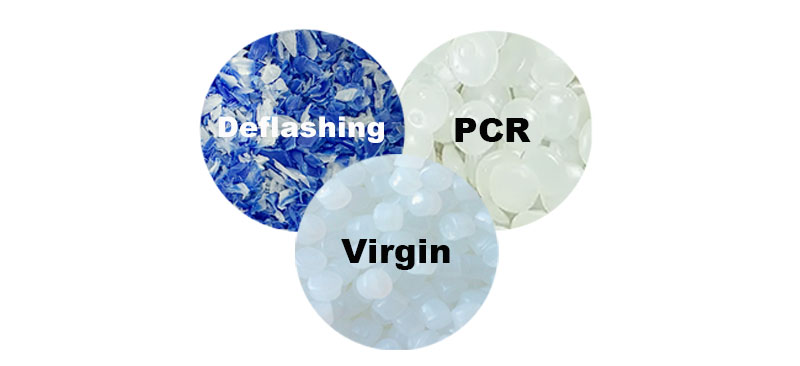
In the working process of IBC tank blow molding machine, due to the length and width of the parison always exceeding the mold cutter, the mold relies on the cutter to cut the parison and form a complete product. Subsequently, workers or machines remove excess waste from the material, which is then crushed by a crusher and recycled as raw material. Therefore, the recycling of crushed materials is extremely important in blow molding production. Due to the large proportion of IBC flashing materials, such as the 14kg IBC inner liner, which contains approximately 4-6 kg of flashing materials, the recycling and reuse of IBC deflashing materials is crucial throughout the entire production process, saving about 40% of raw materials.
How can IBC inner liner recover flashing materials?
We will put the flashing material into a crusher for crushing, and after crushing, the large flashing will be crushed into a maximum size of about 1cm. This crushed material can be used for recycling and reproduction.
What is the proportion of IBC inner tank flashing materials?
For a Chinese standard IBC inner tank of 14/14.5kg, the flashing material is approximately 4-6 kg, accounting for about 22% -30%. The length of the flashing material is very important for energy conservation and consumption reduction. Although there is basically no waste of flashing materials, they can be recycled and reused at around 95% -100%. However, the more flashing materials there are, the waste of heating in the heater, the extension of the production cycle, and more flashing materials entering the feeding system have a greater impact on product quality. Therefore, reducing flashing materials has also become a major demand of various customers. HUAN Machinery has made progress through self developed and multiple case studies, ultimately successfully reducing the flashing material to 3.5kg, achieving a major breakthrough over its domestic counterparts.
What are the components of the IBC inner tank flashing material recycling machine?
Usually, IBC's flashing crushing equipment includes conveyor belts, crushers, and dust recovery systems.
IBC flashing recycling and reuse equipment includes: mixing machine, feeding machine.
What are the precautions for recycling IBC flashing materials?
Attention should be paid to the recycling of IBC flashing materials. It is best to crush them within 30 minutes to 1 hour of natural cooling. The surface is hard, while the inside is soft. This will not cause the crushed particles to stick together and also prevent damage to the crusher blades.
In addition, a magnetic frame can be placed in the hopper of the IBC machine to adsorb the erroneously mixed iron scrap metal from the recycled material onto the magnetic frame.
During the recycling process, black, yellow, and metal materials must not be placed in the recycling system. If yellow and black materials are put into the crusher, black spots will appear on the barrel during the extrusion and recycling process, making it a defective barrel.
HUAN MANINERY's IBC blow molding machine, learning German technology and incorporating self-developed technology, maximizes the optimization of screw die heads, ensuring that there is no coke or black material in the normal production process. Maximize product quality and prevent the occurrence of defective or scrapped barrels.
What is the proportion of flashing material added to the machine?
The proportion of flashing materials added should be the same as the actual weight of flashing produced, which can minimize waste. However, due to varying quality requirements from customers in actual production, some customers may require the use of pure new materials to produce IBC tank. This way, the produced inner liner flashing material cannot be immediately recycled and can only be used for the production needs of other batches.
Usually, the proportion of flashing material in all raw materials is about 20% -30%. If it increases, it will cause a sudden decrease in plasticizing amount due to the plasticizing effect and screw feeding problems, and the length, thickness, and thickness of the material embryo will be uneven. Greatly affects product quality and defect rate.
Usually, we use a two-layer or three-layer IBC blow molding machine, which can use pure new material on the inner layer and recycled material on the outer layer. Ensure the cleanliness of the product, with the inner layer clean and the outer layer saving raw materials. Currently, only Europe, Japan, and China have mature multi-layer technologies that are relatively popular and mature. If pure new materials are used for the inner layer and recycled materials are used for the outer layer, the plasticization requirements for the outer screw will be extremely high, requiring the use of flashing materials to reach 50% -100%.
HUAN MACHINERY can achieve a maximum production capacity of 100% using flashing materials to produce IBC tank. Its unique screw design ensures that even if all recycled materials are used for recycling, there will be no problems. Its stable raw material plasticization ability provides more and better solutions for energy-saving and high-quality IBC inner tanks.












